Yesterday, we looked at the setting for this 19th century embroidered rose. Today, you get to see the rose!
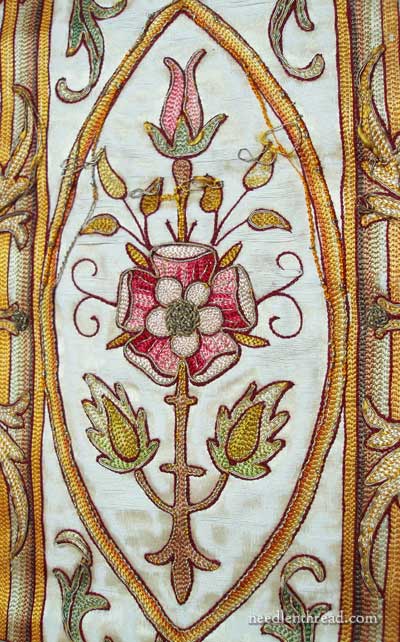
Here it is, the rose element in the center of this tambour work panel of ecclesiastical embroidery. You can see that things around the element are looking a bit ratty, especially towards the top of the design. The metal threads are dislodged around the leaves and around the frame, and the silk cores of the metal threads are also flailing about a bit.
You also notice what looks like some damp spots or stains towards the base of the rose. In fact, those are the areas where the silk weft threads still exist. Anywhere you see that shimmering or spotting, it’s actually from the silk ground fabric. In the other places, most of the silk weft threads are completely gone or so rubbed up that they no longer give off the characteristic sheen of silk.
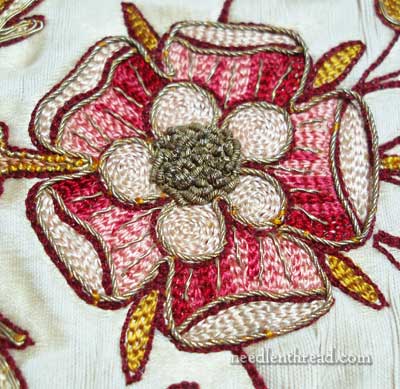
The rose. I do love it. I love the vibrant pinks that have survived! I love the gold twist that’s no longer gold that outlines the whole rose.
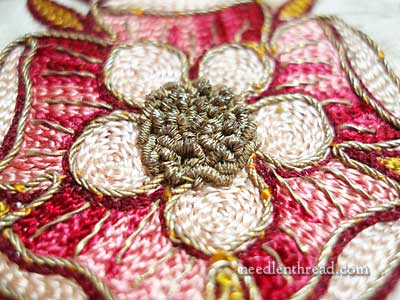
And I love that glorious heap of check bullion in the middle.
Notice that the large petals of the roses are stitched in straight lines radiating from the center. The stitches in the turn-over on the outside of the large petals are perpendicular to the pink stitches inside the petals. And the circular inside petals? Their stitches travel in circles.
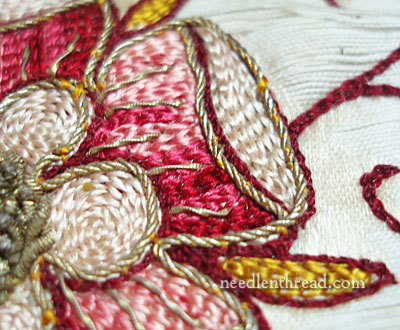
The radiating gold threads on the larger petals is, I believe, flatworm.
I love it for its looks.
But its name – that’s another question!
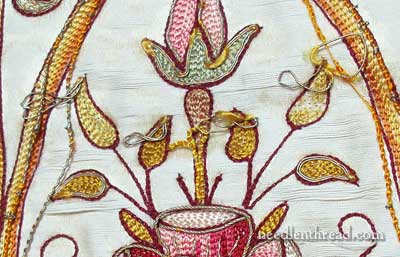
Here, you can see a better shot of the damaged area. Notice the horizontal ground fabric threads. Those are the warp threads that remain. The piece was embroidered so that the warp threads of the ground fabric are horizontal, rather than vertical, as far as the design is situated. They are loose, because they don’t have anything holding them together.
You can see the gold threads lifted from around the leaves, and you can also see that one little leaf in particular on the right, in the center – the highest one up – is practically bare of silk. The gold rococco thread that outlines the “frame” around the rose element is coming off, and where the metal is missing from that thread, you can see a kinked gold thread hanging loose. On the stem below the rose bud, the rococco is also missing, but the kinked gold core thread is still there.
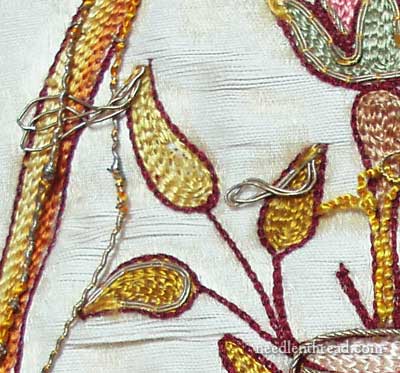
Here, you get a better look at the rococco on the frame and the silk rococco core without its gold wrapping on the stem (far right). You can also see the gold threads coming off the leaves, and a little bit of wearing on the silk stitching in the center leaf.
This area of the whole embroidered pillar is the most damaged, probably because of where it would have fallen on the chasuble it came from. The whole pillar would have adorned the front of a chasuble, and this area would have fallen right in the center of the torso, where hands would be folded and the forearms would rub against it.
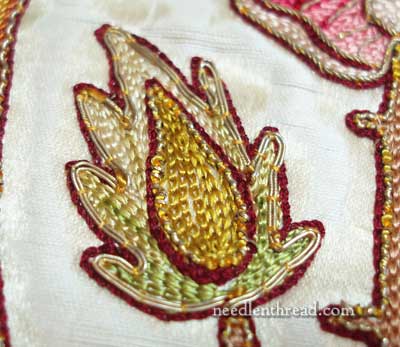
Finally, here’s a look at one of the larger side leaves. It’s in excellent shape! There are five colors of silk in that leaf – three in the outer (two greens – a bright green, a very pale green – and an off-white), one in the center (gold colored silk), and the outline, which is deep red. The inner teardrop shape of the leaf is outlined as well with rococco, and the outer part of the leaf is outlined with a double line of passing thread.
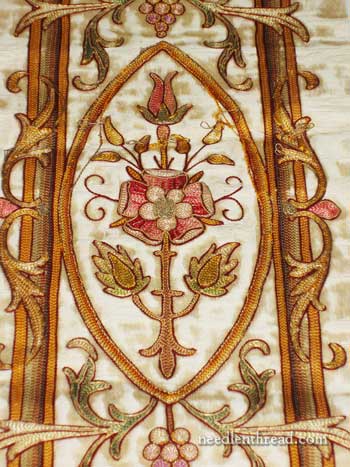
And there, the rose! Do you like it?
Would you like to see what I’m doing with it now? It involves things like… sharp scissors. Soft charcoal. Permanent ink.
Sounds dreadful, doesn’t?







I love it, Mary. It is just beautiful.
I’m sure that you will do what is necessary to preserve this as best you can but all this talk of scissors, charcoal and permenant ink is making me nervous!
Very tempted to visit Kansas right now 🙂 I would love to do some reverse applique with some new silk for it. Looking forward to seeing the patterns you are inspired to create. And how you will preserve it and display it , as it is too pretty to be tucked in a drawer.
Blessings, Sharon
It’s beautiful, Mary. I am interested in what you are doing with it now. But I also wonder about the metal threads. Would gold have tarnished? Doesn’t it always retain its gleam?
Hi Mary
This piece is indeed lovely. In its day it must have been truly stunning with all of the lovely bright silks and magnificent gold work. I am curious, though, as to what exactly you will be doing with charcoal. 🙂 I will definitely stayed tuned. 🙂 Thank you for sharing.
this is so beautiful.
have you done any research into the history of these sort of vestment embroideries and their symbolism ? does this one come from england ? if so i wonder if the rose originally had an underlying agenda – maybe intended as a “political” statement – either as a reference of loyalty to the royalty (tudor rose) or to englishness – (like on the rugby shirts). church of england clergy have been put in some tricky situations sometimes in terms of allegiances and stuff with being a national church.
still i would like to think that it’s just that some woman thought it was a nice idea tho and some vicar liked it and wore it a lot. it is such a beautiful design 🙂
This is a lot of fun, Mary, your review of this piece. I love the bullions, too! Looking forward to the next installment.
So thrilled to see this piece. I cannot help but imagine the hands that stitched it so long ago. How wonderful it would be if they could somehow know their work of love and devotion is to be restored,admired by so many and (possibly) copied.
Regards,
Doreen from Maine
Thank you Mary, for helping us see the embroidery through your eyes. It is beautiful work and you are approaching it with a deep sense of responsibility. I have no idea what you are going to do so am awaiting further updates with intense interest.
Can you explain how this piece was worn? What was it a part of (what was it cut from)? What is a chasuble, and when is it worn?
I know that ecclesiastical is having to do with a church or religion, but my Midwest Protestant upbringing hasn’t brought me into contact with any beautiful embroidery like what you have.
Dear Mary
I’ve really enjoyed your last 2 posts on the antique 19th Century rose. It’s so beautiful and it must have been stunning when the piece was first sewn, I can’t wait to see what you are going to do with scissors, charcoal and permanent ink……….etc……please show us photos!!!
Regards Anita Simmance